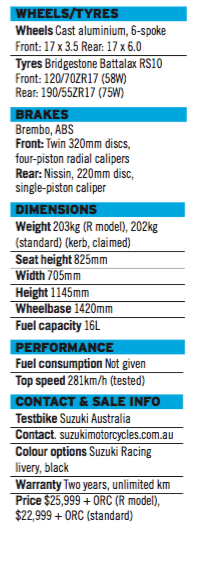It’s been a long time coming, but the new Suzuki GSX-R1000R is on target to claim back the crown it once owned: the King of the Racetrack. There are no pretences that the new Gixxer is just an updated version of the previous incarnation – it is a completely new build. Suzuki claims more than 600 parts are different to the 2016 version, meaning that this bike has had a major shake-up.
To be brutally honest, it needed it. Among the current crop of high-tech superbikes, the old Suzuki 1000 was lagging in the performance department. Although it’s still a very capable machine, sales were slowing and it was time to raise the bar for the new year.
There is certainly a lot of hype around the bike, as there is with all new models, but Suzuki put its money where its mouth is by holding the launch of this new machine at Phillip Island’s iconic GP circuit. When I first walked into the garage and laid eyes on the new GSX-R it was a stunning sight – around 20 machines, each with a dedicated tech to make sure things ran smoothly.
Even better than the techs (sorry techs), Shinichi Sahara was there. Shinichi’s name is synonymous with top-level racing, having worked as Suzuki’s MotoGP project manager and technical director for 13 years, and then before that as technical director for Suzuki’s superbike projects. He was on hand to give his insights and Yoda-like wisdom to those who asked.
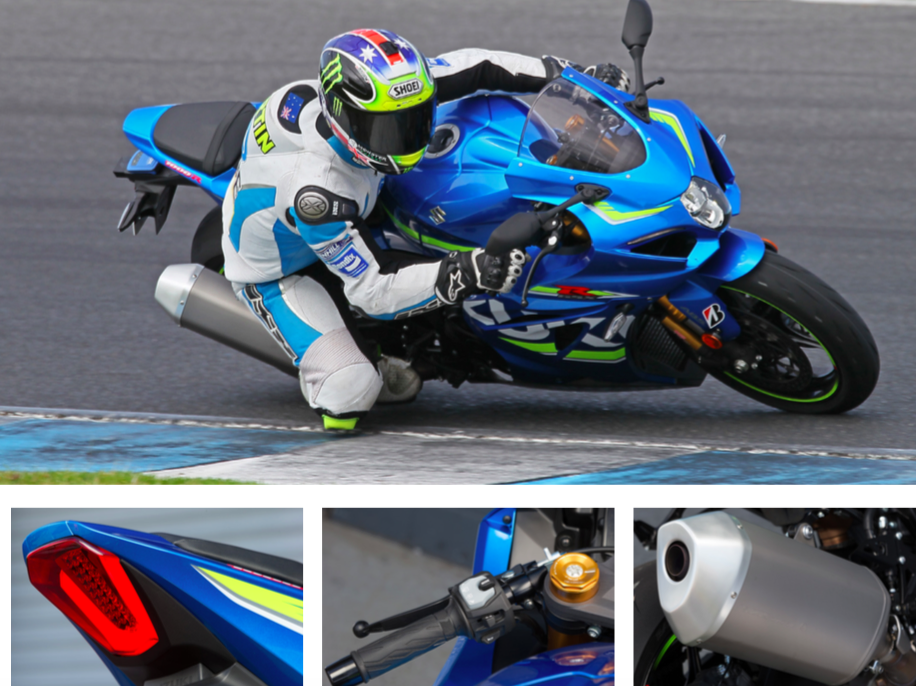
Given Shinichi’s background, it made perfect sense that he be put in charge of this new bike, and for the past four years he has had a major influence on the direction and specification of the GSX-R. It abounds in technology and new ideas, making it an exciting prospect for any buyer in the litre sportsbike market.
Sitting on the GSX-R1000R for the first time was a pleasant surprise. It’s not as cramped as sportsbikes can be, and I certainly didn’t feel weight on my wrists or a long reach to the ’bar. What really stood out though was the amount of movement I could get by sliding my bum forwards or backwards. I think the designers have put a lot of thought into letting you use body weight as a tool to help make the bike turn, stop or run.
It’s a beautifully finished machine. If you thought Suzuki’s quality was top-notch in the past, this bike takes it to another level. Everything is nice and tidy, tucked up out of the way, and even things like the fairing fasteners are more aerodynamic and flatter, helping to make this GSX-R the slipperiest ever.
Starting the bike is an easy affair – with Suzuki’s one-touch system you only need to touch the button and the ECU cranks the starter just enough to get the bike running. And the clutch is incredibly light thanks to the new SCAS (Suzuki Clutch Assist System), which uses ramps to squeeze the clutch pack together under acceleration, reducing the chance of slip normally associated with light springs. A slipper system is also incorporated and works well.
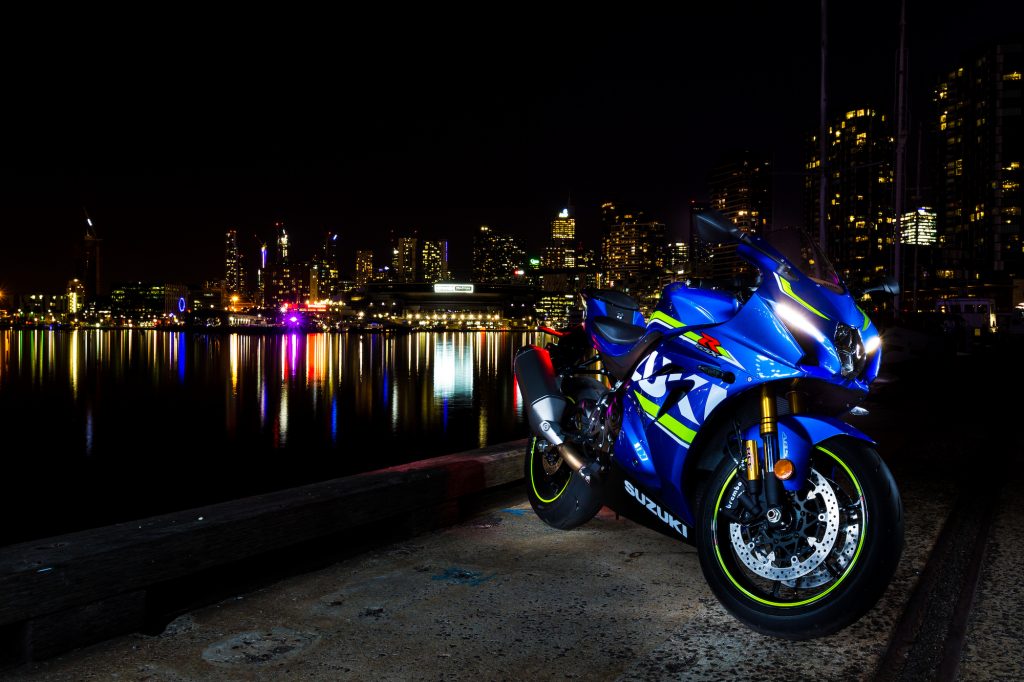
We were allocated five 20-minute sessions, three of those on the standard RS10 Bridgestones and the last two with the gripper R10 track-oriented rubber. We headed out on the R behind Suzuki legend Shawn Giles, who towed us around for a couple of laps to warm up. Even at this pace it was easy to see how advanced the new Suzuki was compared to the old model, and when I opened the throttle on the straight for the first time it was obvious that I was in for a fun day.
This bike is fast. Suzuki claims 148.6kW at 13,200rpm, 12.5kW more than the old bike. The new engine has a shorter stroke than the old mill and normally that would result in a lack of torque, but with the introduction of Variable Valve Timing, Suzuki’s Exhaust tuning alpha set, twin injectors and stacked intake funnels, the new bike has even more bottom-end grunt than the 2016 model. The engine itself is also more compact, sporting a cassette gearbox, completely new castings and a cylinder angle that has been reduced from 32º to 26º. Finger followers are used instead of the old bucket system, reducing weight and lifting the redline to 14,500rpm, 1000rpm higher than the 2016 model.
It’s not only the engine that’s received attention though – the chassis is all new, and it’s certainly got a nice feel to it. As the tyre started to spin, I felt a nice predictable connection from the handlebar to the rear wheel, just like you do on a motocross bike. At this point I should say that the RS10 was not the best OEM tire I have ridden on. There was a lot of spin and when it did break traction it sometimes let go quite quickly. Luckily the traction control with its crank acceleration sensor works well, and averted any disasters.
The benefits of being able to move around on the bike were really evident out on track. I played with my positioning to see if it had much effect on weight transfer, and it really did. I could move my weight back under brakes and forward under acceleration and the bike responded. That’s a great asset to have on a bike with the level of neutral handling characteristics as the GSX-R.
Even though the new bike has a steeper rake and less trail than the 2016 model there was a good feeling of confidence coming from the front end and the new Showa Balance Free Fork. I did have to play with the front settings and added a bit more compression to slow down the movement on lean angle as I was getting some patter, but the changes resolved the problem. The rear spring was soft from the outset and because of that I tended to run a bit wide through the fast corners. I would say that the GSX-R is soft for the racetrack but is harder than a standard R1 Yamaha. Perhaps a good compromise for street and track.

The other major improvement is the fitment of a ride-by-wire system. Finally it has made its way onto a GSX-R, and on a first attempt Suzuki has done a great job of getting it close to right. The all-new electronics package deserves a lot of praise. The throttle connection is quite smooth, perfect most of the time. But at high revs with a closed throttle, getting back on the gas can produce a bit of a jump. In the greater scheme of things, however, it’s one of the better systems available on the market today.
I would hate to think how many kilometres of wire are mating together the array of black boxes that keep the GSX-R in a straight line. Inertial Measurement Units are fitted to all the other major brands now, so Suzuki had to follow suit. This little box is a gyro that tells the motorcycle exactly what attitude it is at. With that information the ECU opens and shuts the butterflies, retards the ignition, and in the Suzuki’s case even activates the ABS to help keep the rear wheel on the ground. You can feel the pulsing through the brake lever, but if you apply more pressure the bike slows, making it one of the better systems I have used. Under extreme braking it will run on though, so for trackday riders and race use the ABS will need to be turned off.
After lunch we headed out on track with the medium compound Bridgestone R10 tyres fitted. These are a more track-oriented tyres and there was a lot more grip available than with the OEM tyres. It’s amazing how much more speed we could carry through the fast corners, but I’m the first to admit I didn’t get the most out of them. I was a bit gun shy due to the moments I had on the street rubber earlier in the day and decided to have fun rather than set a real lap time. That did allow me, however, to concentrate more on different aspects of the bike.
The new aerodynamic package is a masterpiece. It’s lower than the old bike and narrower too, but when you are hitting 280km/h plus down the main shoot at the Island you can tuck down with room to spare. The wind flows right over the top of the pilot, providing a much easier ride. The Suzuki development team must have spent a massive amount of time in the wind tunnel to get that right – in fact they’ve spent a lot of time getting it all right.
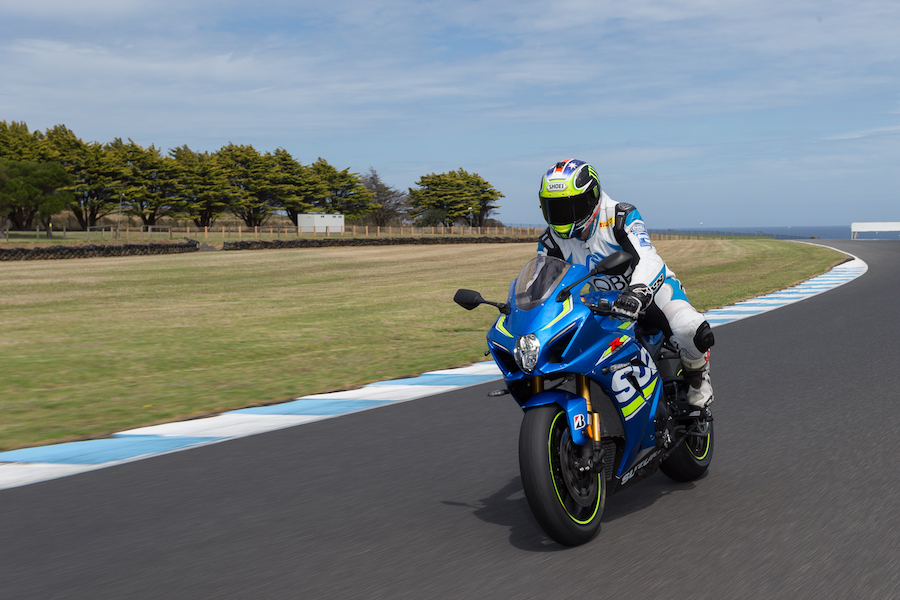
At the end of the day we watched the Suzuki test rider do a launch control start. It would have been nice to try that myself, but none of the journos were given the chance. Hopefully it won’t be long until we can get our hands on the new model again and have a play.
Looking at the overall GSX-R1000R package, you have to say that Suzuki has lifted its game. I’m guessing it’s going to be the company’s flagship for a fair while to come, which explains the effort. I did every lap of every session available on the day, which means it’s a bike worth riding.
But is it a game changer? The new GSX-R1000R has definitely moved back up near the top of the heap. As for whether it can make Suzuki King of the Racetrack again, only history will be the judge of that.
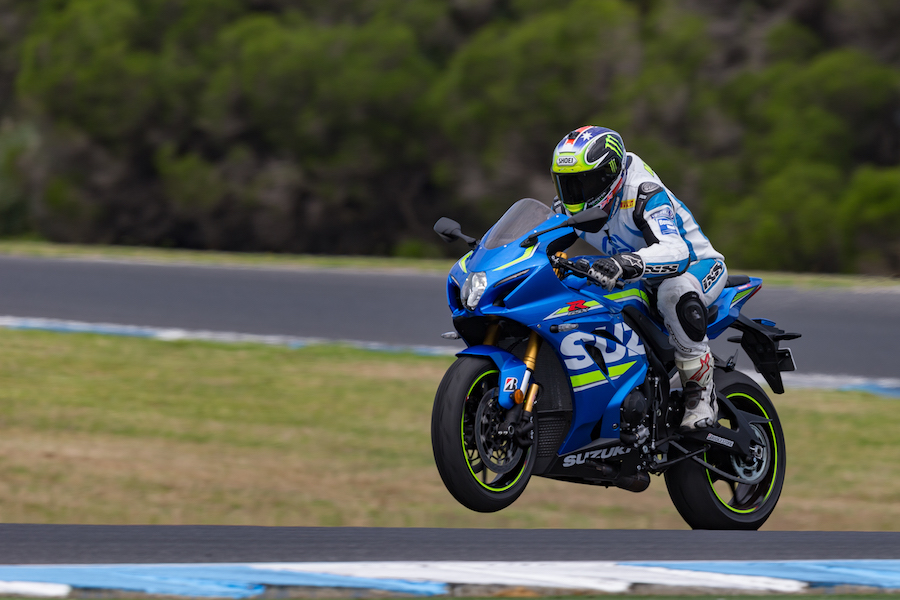
Evolution of the GSX-R
1984
The first GSX-R broke cover at Germany’s Cologne motorcycle show in September. After its release in ’85, that first slab-sided 750 was the start of something very special for Suzuki. For the first time, real racing technology had hit the streets, and the bike with its alloy frame and new oil-cooled 750cc engine ruled racetracks around the world.
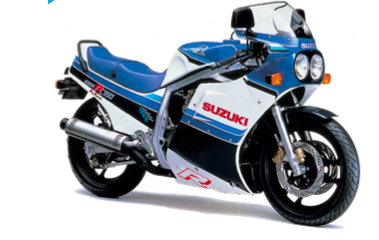
1986
The GSX-R1100 hit our shores with a larger torquier motor and a longer wheelbase. Unlike the 750, it was aimed at the road scratcher rather than the racer. It was the first ever production motorcycle to be fitted with a cartridge front fork, and although it still had the race DNA of the 750 it was a much more user-friendly machine for the everyday rider.
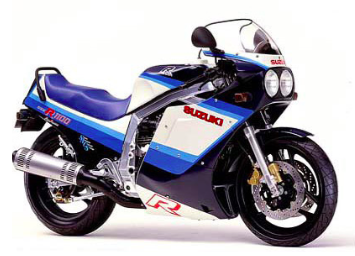
1988
An updated 750 was released with a shorter/stroke engine, punched out to 748cc. Although modest power gains were attained, the competition had moved on to water cooling and the short/stroke version of the GSX-R was starting to be fall behind.
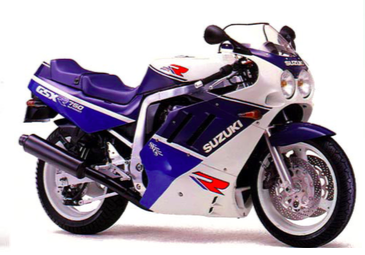
1992
The WN water-cooled engine was used for the first time. The new 750 was more powerful than the old one, but its handling suffered. It also piled on a ton of weight, meaning racetrack success worldwide was limited.
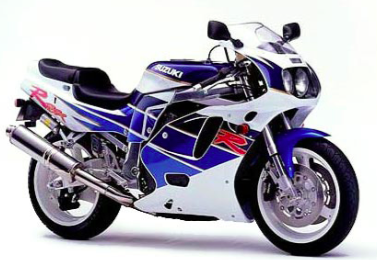
1996
It took Suzuki four years but it hit back with a vengeance. The SRAD was a beautiful machine that was light and handled well – and put the GSX-R moniker back on track. Peter Goddard took out the Australian Superbike Championship, giving Suzuki its first title since Tony Armstrong won on the original slab.

2001
It was early in the new century when the first 1000cc GSX-R K1 was introduced. It was built to beat Yamaha’s R1, which had taken top dog spot in 1998. Shawn Giles used the bike to good effect by winning the 2001 Australian Superbike Championship.
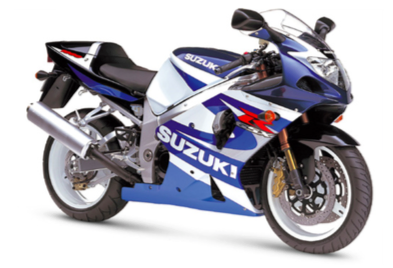
2005
The K5 version was released and was lighter and more powerful again. Handling was also improved. Dual injectors and a slipper clutch helped Troy Corser power to his second WSBK title.

2012
It was a special year for the Japanese manufacturer as it sold the millionth GSX-R. A special edition with gold fork tubes and a special paint job helped commemorate the amazing achievement.
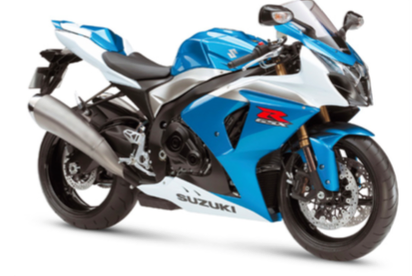
It’s electrifying!
Dash
The all-new dash is clean and simple with a bar-type tacho that runs around the outside from bottom left to top right. Gear position is easy to read, as are the traction and mode settings. A fuel gauge is slotted on the bottom left with the usual trip computer in the right bottom corner. It works well out on the track, as the information just seems to fall to your eye.
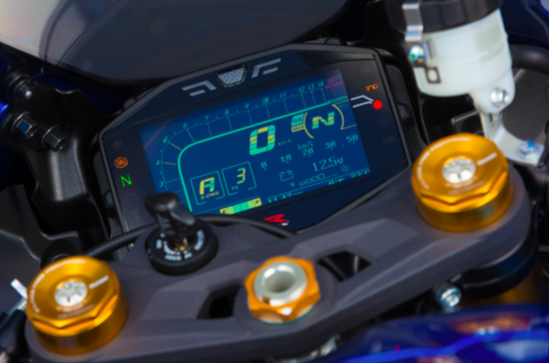
Bi-directional Quick Shift System.
No need to use the clutch for up shifts or down shifts on the GSX-R. The new quickshift system replicates those used in WSBK and MotoGP. A sensor is activated when the rider touches the gear lever that sends a message to the ECU. The ignition cuts for up shifts and opens the butterflies an auto blip system on the down shift.
Motion Track Traction Control System (TCS)
One of the fastest processors in the business takes in readings from various sensors every 0.004 of a second. The GSX-R TCS is no simple system either, using an IMU to calculate pitch yaw and roll of the motorcycle. Crank speed, wheel speed, throttle grip and throttle valve position sensors all tie in together to make this 10-position traction control system one of the best in the business. It’s a pity you have to chop the throttle shut to change the settings.
Suzuki Drive mode (S-DMS)
As on the previous model, Suzuki has a choice of three power modes: A, B or C. On the old model, however, these maps were only a retarded by ignition variant and although they made a difference the 2017 version is much improved. Suzuki now uses a ride-by-wire system to alter the throttle-grip-to-butterfly ratio, giving the feeling of a longer throttle in C mode, or a much more direct throttle response in A mode. Full power is still available in all modes.
Launch Control
With all the extra electronic aids available this year it only made sense to fit launch control. This is like the system fitted to WSBK-spec machines. Once engaged you can hold the throttle grip to the stop while a pre-determined launch rpm rev limiter keeps the bike from over revving. While you concentrate on feeding out the clutch, the ignition and throttle body butterflies work in the background to keep you in the meat of the power and the bike in the right attitude.

Suzuki Easy Start System.
One touch is all that’s needed to get the starter motor turning over enough to fire the GSX-R up. The bike will also now start in neutral without pulling the clutch in, which is a godsend when warming up.
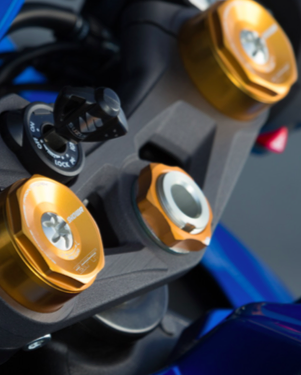
Low RPM Assist
Sensors fitted to the clutch system feed an extra small burst of power depending on speed and rpm to assist the rider in heavy traffic and reduce the risk of stalling at an inopportune moment. Definitely a big plus and allows you to concentrate on other matters.
Electronic Steering Damper
Damping gets stiffer as the GSX-R gets up to racing speeds, keeping the bike in line. At low speeds the damper is automatically backed right off, allowing easy manoeuvrability around town.
Motion Track Braking system
This little black box takes information from the IMU to adjust the brake pressure via the ABS system to keep the rear wheel in contact with the ground. The Motion Track Braking system also adjusts the ABS settings according to lean angle.
TEST STEVE MARTIN PHOTOGRAPHY SUZUKI AUSTRALIA

